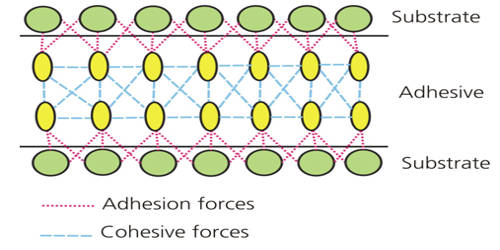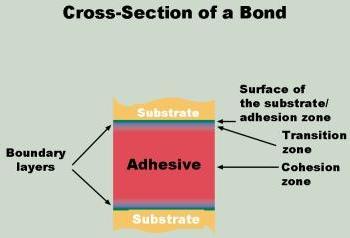Science of Adhesion


What is Bonding?
Bonding is the joining of two substrates using an adhesive. According to DIN EN 923, an adhesive is defined as a non-metallic binder that acts via adhesion and cohesion. ASTM D907-06 defines an adhesive as “a substance capable of holding materials together by surface attachment”.
Note: much of the material in this and the subsequent pages is extracted from ChemQuest’s North American Adhesive Bonding Professional Training Course. To learn more and to register for any of their courses click HERE.
Overview of Adhesion & Cohesion
Adhesion is the adhering of similar or different types of materials to each other. Cohesion is the inner strength of a material, such as the adhesive in this case.
The adhesive interactions between an adhesive and a substrate not only concern the actual area of contact (adhesion zone) of the adhesive and substrate but also concern the state of the adhesive in the vicinity of the surface of the substrate (transition zone).
In the cohesion zone, the adhesive is present in its normal state.
In the adhesion zone, the adhesive has a modified structure and composition due to its adhesion to the surfaces of the substrates. This structure and composition is different from the state in the cohesion zone. As a result, the macroscopic properties of the adhesive in the adhesion zone are also altered.
The structure, composition and macroscopic properties of the adhesive continuously change in the transition zone between the adhesion zone and the cohesion zone. There may for example be separation of the components of the adhesive due to diffusion of the small components of the adhesive into surface pores. The optimum composition of the adhesive is hence adversely affected.

